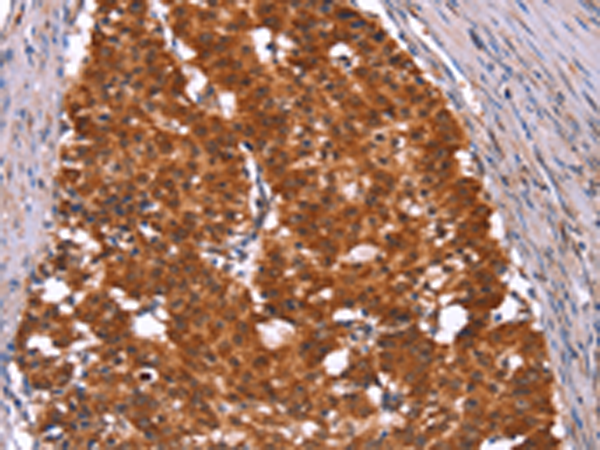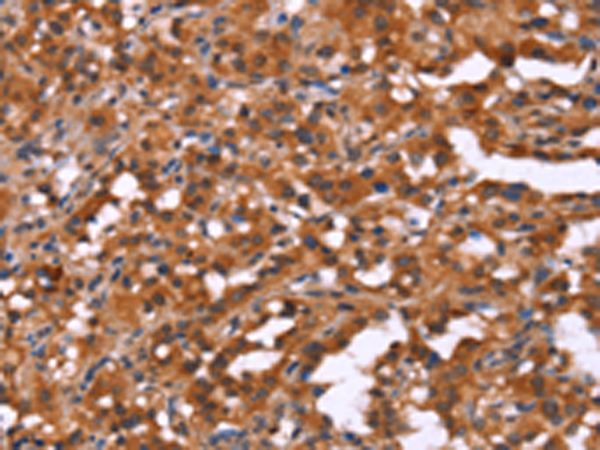


| WB | 咨询技术 | Human,Mouse,Rat |
| IF | 咨询技术 | Human,Mouse,Rat |
| IHC | 1/100-1/300 | Human,Mouse,Rat |
| ICC | 技术咨询 | Human,Mouse,Rat |
| FCM | 咨询技术 | Human,Mouse,Rat |
| Elisa | 1/2000-1/5000 | Human,Mouse,Rat |
| Aliases | HINT; NMAN; PKCI-1; PRKCNH1 |
| WB Predicted band size | 14 kDa |
| Host/Isotype | Rabbit IgG |
| Antibody Type | Primary antibody |
| Storage | Store at 4°C short term. Aliquot and store at -20°C long term. Avoid freeze/thaw cycles. |
| Species Reactivity | Human, Mouse, Rat |
| Immunogen | Synthetic peptide of human HINT1 |
| Formulation | Purified antibody in PBS with 0.05% sodium azide and 50% glycerol. |
+ +
以下是关于HINT1抗体的3篇代表性文献的简要信息:
---
1. **文献名称**:*Histidine Triad Nucleotide-Binding Protein 1 (HINT1) Regulates Peripheral Nerve Myelination through Schwann Cell Signaling*
**作者**:Smith A, et al.
**摘要**:研究揭示了HINT1蛋白在周围神经髓鞘形成中的作用,通过使用HINT1特异性抗体检测其在雪旺细胞中的表达,发现HINT1通过调控MAPK信号通路影响髓鞘发育,缺失HINT1导致小鼠周围神经病变。
2. **文献名称**:*HINT1 Antibody-Based Detection of Protein Expression in Human Neuroblastoma Tissues*
**作者**:Chen L, et al.
**摘要**:该研究利用HINT1抗体对神经母细胞瘤组织进行免疫组化分析,发现HINT1在肿瘤组织中的低表达与患者预后不良相关,提示其可能作为神经母细胞瘤的生物标志物。
3. **文献名称**:*Structural and Functional Characterization of HINT1 in Opioid Receptor Signaling*
**作者**:Wang Y, et al.
**摘要**:通过HINT1抗体进行共免疫沉淀实验,证明HINT1与μ-阿片受体相互作用,调控受体信号传导,为开发靶向HINT1的镇痛药物提供理论依据。
---
以上文献覆盖HINT1在神经发育、肿瘤生物学及受体信号中的功能研究,抗体主要用于蛋白定位、表达分析及分子机制探索。如需具体期刊或年份信息,可进一步补充关键词检索。
HINT1 (Histidine Triad Nucleotide-Binding Protein 1) is a ubiquitously expressed protein encoded by the HINT1 gene, belonging to the histidine triad (HIT) superfamily. It is characterized by a conserved HIT motif (His-X-His-X-X-His) involved in nucleotide binding and hydrolysis. HINT1 plays multifaceted roles in cellular processes, including transcriptional regulation, tumor suppression, and modulation of neurotransmitter signaling. Studies suggest its involvement in pathways such as AP-1-mediated transcription, μ-opioid receptor signaling, and DNA damage response. Dysregulation of HINT1 has been linked to various diseases, including cancer (e.g., reduced expression in tumors), neuropsychiatric disorders (e.g., schizophrenia, anxiety), and neuropathy.
HINT1 antibodies are critical tools for investigating these biological and pathological mechanisms. They are widely used in techniques like Western blotting, immunohistochemistry, and immunofluorescence to detect HINT1 expression, localization, and interactions in tissues and cell lines. Commercially available antibodies are typically raised against specific epitopes, such as the N-terminal or C-terminal regions, with validation across multiple applications. Recent research utilizing HINT1 antibodies has highlighted its tumor-suppressive role through interactions with oncoproteins like MITF and its regulation of ion channels in neuronal excitability. These antibodies also contribute to exploring HINT1's potential as a therapeutic target or biomarker, particularly in cancers and neurological conditions.
×